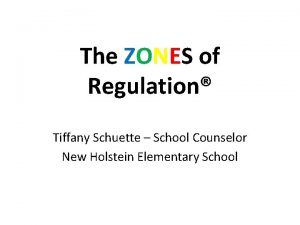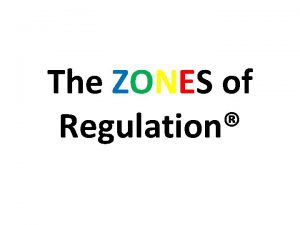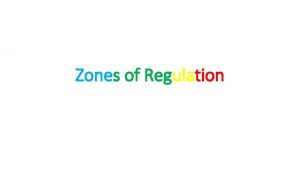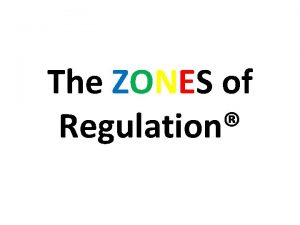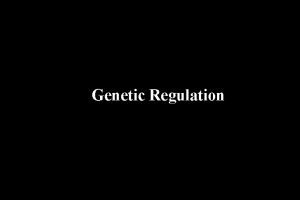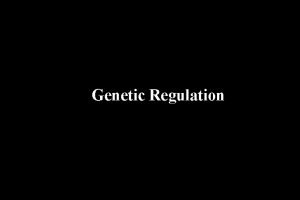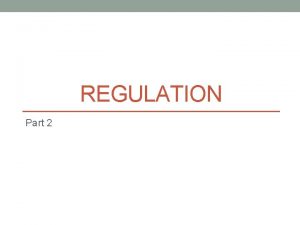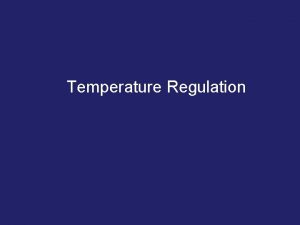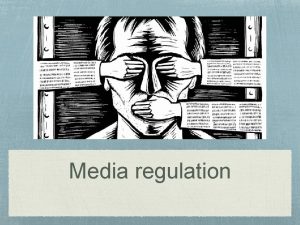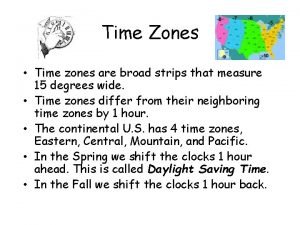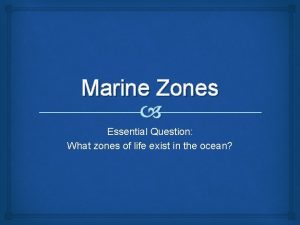The ZONES of Regulation What are The ZONES












- Slides: 12

The ZONES of Regulation®

What are The ZONES of Regulation®? • The ZONES is a concept designed by Leah Kuypers, licensed occupational therapist, to help students gain skills in the area of self-regulation. • Self-regulation can go by many names, such as selfcontrol, self-management, and impulse control. It is defined as the best state of alertness of both the body and emotions for the specific situation. • For example, when a student plays on the playground or in a competitive game, it is beneficial to have a higher state of alertness. However, that same state would not be appropriate in the library.

What are The ZONES of Regulation®? • The ZONES are designed to help the students recognise when they are in different zones as well as learn how to use strategies to change or stay in the zone they are in. • In addition to addressing self-regulation, the students have an increased vocabulary of emotional terms, skills in reading other people’s facial expressions, perspective about how others see and react to their behaviour, insight into events that trigger their behaviour, calming and alerting strategies, and problem solving skills.


How are the ZONES useful? • A critical aspect of the Zones is that all team / staff members know and understand The ZONES language. • This creates a comfortable and supportive environment for the student to practice his or her self-regulation skills.

How are the ZONES useful? You can support the student during this process by doing the following: • Use the language and talk about the concepts of The ZONES as they apply to you in a variety of environments. • Make comments aloud so the student understands it is natural that we all experience the different zones and use strategies to control (or regulate) ourselves. For example, “This is really frustrating me and making me go into the Yellow Zone. I need to use a tool to calm down. I will take some deep breaths. ”

There is no such thing as a bad ZONE. • It is important to note that everyone experiences all of the zones—the Red and Yellow Zones are not the “bad” or “naughty” zones. • This is different to a classroom behaviour chart. • All of the zones are expected at one time or another. • The Zones of Regulation is intended to be neutral and not communicate judgment.

ZONES Videos What is Self Regulation? https: //www. youtube. com/watch? v=m 4 UGDa. Cgo_s J https: //www. youtube. com/watch? v=3 b. Kuo. H 8 Ck. Fc&t=60 s (looks at it from brain mechanics and your physiological reactions) https: //study. com/academy/lesson/emotion-regulation-and-aggression. html (from an Early Childhood perspective and shows that if a child misses this learning in their development, they are 'stuck' at a particular developmental stage and need to be 'taught' this to move forward along their developmental pathway. https: //focusedkids. org/what-you-need-to-know/self-regulation/ - all kids can learn it…all ages!

Why teach "Social-Emotional Skills" https: //www. virtuallabschool. org/preschool/social-emotional/lesson-1 Fun Clips about Emotional Regulation https: //www. youtube. com/watch? v=y. RUAz. GQ 3 n. SY Reinforcing the notion that all emotions are OK and that understanding emotions are the first step to being able to respond appropriately to get our needs met. https: //www. youtube. com/watch? v=82 EKia. Lhn. Gc Zones of Regulation website: http: //www. zonesofregulation. com/

ZONES More Videos What it looks like to be in the Blue Zone (Barbie crying and upset): http: //www. youtube. com/watch? v=a 5 ze 5 Pf. DEz. I&index=2&list=PL 87 B 22 B 04 EC 463 D 3 B What it looks like to be in the Green Zone: (Finding Nemo: Just Keep Swimming): https: //www. youtube. com/watch? v=s. B 6 W 2 VAx 2 J 8 What it looks like to be in the Yellow Zone (Mike’s New Car): https: //www. youtube. com/watch? v=e. Iy. TCUX 6 DUg What it looks like to be in the Red Zone (Lucy mad in Charlie Brown): http: //www. youtube. com/watch? v=pq 9 h. BEv. FNl. M&list=PLD 7 C 6 A 7 4 DFECE 6 B 3 F&index=1

Other Tools and ZONES Visuals

Benefits to The ZONES at the Primary School Level • LANGUAGE!!!! A common language for all staff to use with students. – For example: A student comes to school in the morning and looks tired and is moving slowly. A teacher can say “You seem like you are in the Blue Zone. ” The student recognises they are in the Blue Zone and then uses strategies to move to Green. • The Zones of Regulation are simple for kids to understand. • Kids know the different colors, recognise their feelings and use strategies to move to Green Zone (calm down or feel okay). • As a result students learn to self-regulate.

